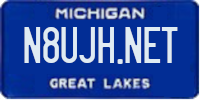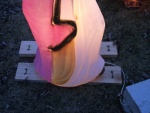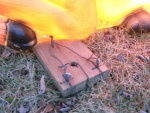 Anchoring Blowmold Figures
Anchoring Blowmold FiguresLike anyone whose Nativity Scene is composed of blowmold figures, the wind is a consant problem with blowing the figures over. I've had parts of my Nativity Scene since 1995 and have tried various techniques over the years with various degrees of success. Below is the technique I settled on that in 2012 is fairly universal and not dependent upon the diameter of the hole in the base of the piece.
For eace piece you wish to anchor, the following will be needed. All parts were purchased at Menards, a home improvement center:chain based in the upper midwest that happens to also be my employer.
- Two cedar 1x4 boards cut to 18 inches long.
- Four 5/16" x 2 hex bolts
- Four 5/16" washes
- Four 5/16" hex nuts
- Four landscape edging staples
 Drill four 3/8
diameter holes into the cedar board. The holes are 1 5/8" in from the ends. For the other
dimentions, center the staple's legs over the centerline. My staples have legs 1" apart so
my holes are 1 1/8 in from the edges.
Drill four 3/8
diameter holes into the cedar board. The holes are 1 5/8" in from the ends. For the other
dimentions, center the staple's legs over the centerline. My staples have legs 1" apart so
my holes are 1 1/8 in from the edges.
Now attach the
boards to the base of each piece. As
placement here will vary due to the diameter of the hole in the base, I am not providing
measurements. In general, try not to cover the hole in the character base and keep an equal
amount of board in front of and behind each piece. Four holes will be drilled into the base of
each character. General layout for the holes is a square shape with corners (holes) centered
between the big hole and the outer edge of the base. The holes are 3/8 diameter and drilled
through the board and the base. Insert a bolt through the board and the newly drilled hole in
the character base. Now reach in through the big hole and place a washer and hex nut on the bolt
shaft and hand tighten. Repeat for drilliing a hole on the other side of the board and then
repeat for the other boar.

Lastly, place a landscape edging staple through the two
holes on each end of each board.

The above technique was adopted from one in use for ten
years to keep a camel from tipping over. Instead of drilling and bolting, twelve screw eyes were
used. One screweye goes into each corner of the camel's base and two screw eyes go into each
end of the two boards. Lastly, stiff wire is run through the camel screw eye anchored on the
two board screweyes. Repeat this for the other three corners.